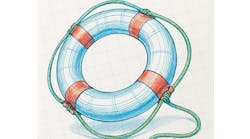This article is part of a series on industrial sustainability. Read more here.
Because it's relatively new, sustainability can seem like a separate topic from automation and process control. However, it's actually closely entwined with all the usual goals from efficiency and waste reduction to regulatory compliance, and can help and be enabled by all of them.
"Manufacturers are more in tune with sustainability than when I started my career many years ago. It's been a slow evolution, but looking at things today, the differences are stark. The best way to characterize it now is that sustainability is a consideration on every project we see, if not directly, then certainly indirectly," says Michael Gurney, president and CEO of Concept Systems, Albany, Ore., a certified member of the Control System Integrators Association (CSIA). "In most projects we see, reducing waste is an ROI consideration that equates to reducing costs. It may seem like common sense now, but this wasn't always the case. Another factor is regulations for protecting the environment, which make it costly to be wasteful. In the past, it may have been more cost-effective to bring in raw materials, pull the value out of them, and dump the rest as waste. However, I can't think of many examples where that's the case anymore.
"There's also a cultural element for sustainability in manufacturing, where there's a sense of pride in working for companies that include sustainability in their mission statements. It's pretty common to see now, and when you walk into their facilities, it's easy to see that higher purpose. It's more than ‘manufacture lots of parts.’ It's ‘manufacture lots of parts in a responsible manner.' We love this for the obvious reason that we care about our environment, too, but there's also an appreciation for automation because it's also the key to getting the most out of our raw materials."
Knowledge targets efficiency
Gurney adds there are hundreds of ways to achieve efficiency with automation, so it's not uncommon to tour a manufacturing facility and be able to identify 10 automation projects that can improve efficiency. This involves looking at each process, considering available technologies, and knowing how to apply them.
"Step one is understanding the processes and the data behind them. In many cases, it's a matter of analyzing the data, but in others, we need to add sensors to gather the right data," explains Gurney. "It's not a difficult or expensive process to get to the point where you understand the process. With process and automation knowledge, we can target where to focus our efforts. For example, if we see across-the-line stators on motors controlling a variable-load process, it's likely a good candidate for variable frequency drive (VFD) control or pressure- compensated pumps. Or, if a manufacturer is on a periodic maintenance schedule with equipment, it likely makes sense to add sensors to the equipment to monitor it, so they can shift to a preventive maintenance schedule—maintaining the equipment at the right time, as opposed to a scheduled time, which is invariably too early or two late.
Gurney reports that robotic painting has direct and tangible sustainability benefits compared to manual painting. "With robotic painting, we've generated results where overspray is reduced by over 30%. This is simply a matter of putting the paint nozzle in the right location and maintaining precise control throughout the painting process of the entire part," says Gurney. "There's no doubt that expert painters do an amazing job, but it's a hand-eye coordination exercise that takes years to perfect, and can still vary day to day. People can't replicate the precision and repeatability of a robot. Robots also do a superior job of holding tolerances on parts, specifically paint thickness. When it comes to painting, too much or too little paint can cause problems. Similar to the reduction in overspray, we've provided systems with a reported 30% reduction in quality rejects, which ultimately reduces waste and increases throughput. There are a number of sustainability aspects to point to, but fundamentally, reducing the amount of wasted paint, reduces the amount of paint required to achieve the production required, which keeps paint out of our waste stream and reduces raw material demand and the energy to manufacture paint."
Awareness, understanding begin at home
To develop and accomplish sustainability objectives, Gurney advises his team to learn about the business drivers of Concept's customers and work to understand their processes. "We actively monitor technology advances, which evolves at an ever increasing rate," he says." If you couple the business/process knowledge with the technology expertise, you can solve challenging problems in really cool ways."
Gurney believes plant-floor sustainability initiatives will continue at their present pace into the future. "This is a very positive trend. I feel corporate America understands their responsibility and is taking it seriously," adds Gurney. "My hope is seeing more reshoring initiatives, where we commit to manufacturing in the U.S. and take sustainability seriously, rather than in foreign countries, where the same standards may or may not exist.
"I'm also eager to see how things evolve with battery-operated vehicles/technology. I believe there are challenges with waste streams and raw material sourcing that will present significant challenges for electric vehicles and similar equipment becoming mainstream. Whether this is better or worse than oil/gas, I'm not convinced has been fully vetted out. At a minimum, if it has, it hasn't been well publicized, at least in the circles I run in."







